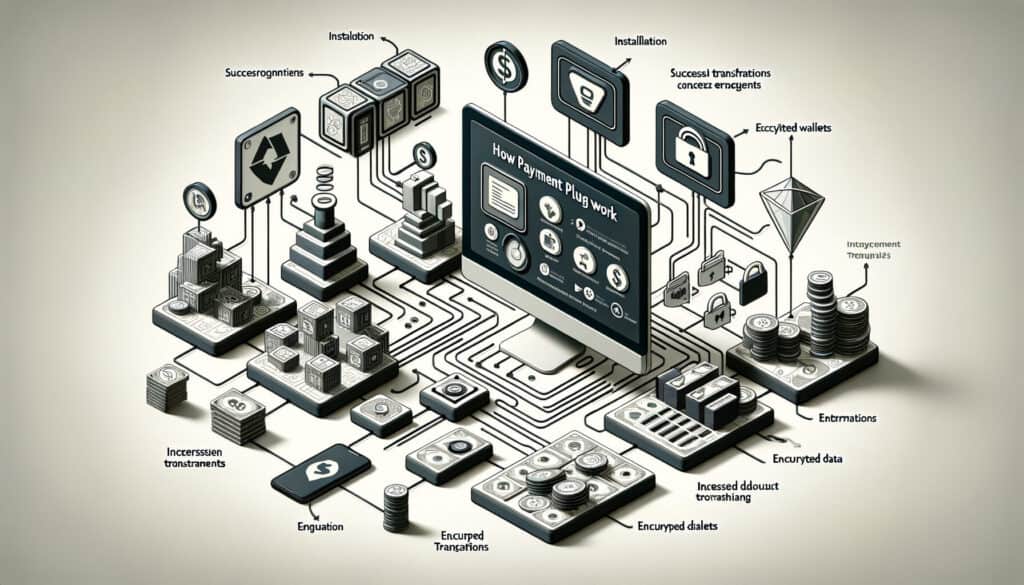
By Crystal Hopkins November 8, 2024
In today’s digital age, online transactions have become an integral part of our lives. Whether it’s purchasing products from an e-commerce website or subscribing to a service, the ability to make secure and convenient payments is crucial. This is where payment plugins come into play. Payment plugins are software extensions that enable websites to accept and process online payments. They act as a bridge between the website and the payment gateway, ensuring a seamless and secure transaction process.
Payment plugins are essential for any business that operates online. They provide a convenient and efficient way for customers to make payments, increasing customer satisfaction and ultimately boosting sales. Without payment plugins, businesses would have to rely on manual payment processing methods, which are time-consuming and prone to errors. Additionally, payment plugins offer a wide range of features and customization options, allowing businesses to tailor the payment process to their specific needs.
Understanding the Basics: How Do Payment Plugins Work?

To understand how payment plugins work, it’s important to first understand the components involved in an online payment transaction. The key components include the website, the payment gateway, and the customer’s payment information. Payment plugins act as a middleman between these components, facilitating the transfer of information and ensuring a secure transaction.
When a customer initiates a payment on a website, the payment plugin captures the necessary payment details, such as the customer’s credit card information or PayPal account details. It then securely transmits this information to the payment gateway, which processes the payment and communicates the result back to the website. The payment plugin also handles any necessary data validation and error handling, ensuring a smooth and error-free transaction process.
Exploring Different Types of Payment Plugins

There are various types of payment plugins available in the market, each catering to different business needs and requirements. Some of the most common types include:
- Direct Payment Plugins: These plugins allow customers to make payments directly on the website, without being redirected to an external payment page. They offer a seamless user experience and are often preferred by businesses that want to maintain control over the payment process.
- Redirect Payment Plugins: These plugins redirect customers to an external payment page hosted by the payment gateway. Once the payment is processed, customers are redirected back to the website. Redirect payment plugins are commonly used by businesses that prioritize security and want to offload the responsibility of handling sensitive payment information.
- Wallet Payment Plugins: These plugins enable customers to make payments using digital wallets, such as PayPal, Apple Pay, or Google Pay. They offer a convenient and fast payment option, as customers can simply log in to their wallet account and authorize the payment.
- Subscription Payment Plugins: These plugins are specifically designed for businesses that offer subscription-based services. They automate the recurring payment process, ensuring that customers are billed on a regular basis without any manual intervention.
Popular Payment Plugins in the Market: A Comparative Analysis

With a plethora of payment plugins available in the market, it can be overwhelming for businesses to choose the right one. To help you make an informed decision, let’s compare some of the most popular payment plugins:
- WooCommerce Payment Plugins: WooCommerce is a widely used e-commerce platform that offers a range of payment plugins. Some popular options include PayPal, Stripe, and Authorize.net. These plugins integrate seamlessly with WooCommerce and provide a secure and reliable payment processing solution.
- Magento Payment Plugins: Magento is another popular e-commerce platform that offers a variety of payment plugins. Some notable options include Braintree, PayPal, and Amazon Pay. These plugins offer advanced features and customization options, making them suitable for businesses of all sizes.
- Shopify Payment Plugins: Shopify is a user-friendly e-commerce platform that offers its own payment gateway called Shopify Payments. It also supports various third-party payment plugins, such as PayPal, Stripe, and Klarna. These plugins provide a seamless integration with Shopify and offer a range of features to enhance the payment experience.
Step-by-Step Guide: How to Install and Configure Payment Plugins

Installing and configuring payment plugins may vary depending on the e-commerce platform you are using. However, the general steps involved are as follows:
- Choose the desired payment plugin: Research and select the payment plugin that best suits your business needs.
- Download and install the plugin: Download the plugin from the official website or marketplace and install it on your e-commerce platform.
- Configure the plugin settings: Access the plugin settings and configure them according to your preferences. This may include entering your payment gateway credentials, enabling specific features, and customizing the payment process.
- Test the payment process: Before making the plugin live, it’s crucial to test the payment process to ensure everything is functioning correctly. Make a test purchase and verify that the payment is processed successfully.
Ensuring Security: How Payment Plugins Safeguard Transactions
Security is of utmost importance when it comes to online payments. Payment plugins employ various security measures to safeguard transactions and protect sensitive customer information. Some common security features include:
- Encryption: Payment plugins use encryption protocols, such as SSL (Secure Sockets Layer) or TLS (Transport Layer Security), to encrypt the data transmitted between the website and the payment gateway. This ensures that the payment information remains confidential and cannot be intercepted by unauthorized parties.
- Tokenization: Payment plugins often utilize tokenization, which replaces sensitive payment information with a unique token. This token is then used for future transactions, eliminating the need to store sensitive data on the website.
- Fraud detection: Many payment plugins incorporate fraud detection mechanisms to identify and prevent fraudulent transactions. These mechanisms analyze various factors, such as transaction patterns, IP addresses, and customer behavior, to detect suspicious activity.
Integrating Payment Plugins with E-commerce Platforms
Integrating payment plugins with e-commerce platforms is essential for businesses to accept online payments. Most e-commerce platforms offer built-in integration options for popular payment plugins, making the process relatively straightforward. Here are the general steps involved in integrating payment plugins with e-commerce platforms:
- Choose the desired payment plugin: Select the payment plugin that is compatible with your e-commerce platform.
- Install the plugin: Follow the installation instructions provided by the payment plugin provider to install the plugin on your e-commerce platform.
- Configure the plugin settings: Access the plugin settings within your e-commerce platform and configure them according to your preferences. This may include entering your payment gateway credentials and enabling specific features.
- Test the integration: Before making the integration live, it’s crucial to test the payment process to ensure everything is functioning correctly. Make a test purchase and verify that the payment is processed successfully.
Optimizing User Experience: Customization and Features of Payment Plugins
Payment plugins offer a range of customization options and features to optimize the user experience. Here are some key aspects to consider when customizing and selecting payment plugins:
- Branding: Many payment plugins allow businesses to customize the payment page to match their branding. This helps create a consistent and professional user experience.
- Payment methods: Different payment plugins support different payment methods. It’s important to choose a plugin that supports the payment methods preferred by your target audience.
- Mobile optimization: With the increasing use of mobile devices for online transactions, it’s crucial to select a payment plugin that offers a seamless mobile experience. This includes responsive design and support for mobile wallets.
- One-click payments: Some payment plugins offer the option for customers to save their payment information for future purchases, enabling one-click payments. This reduces friction in the checkout process and improves conversion rates.
Troubleshooting Common Issues with Payment Plugins
While payment plugins are designed to be user-friendly, issues may arise from time to time. Here are some common issues with payment plugins and their possible solutions:
- Payment gateway connection errors: If you encounter connection errors with the payment gateway, double-check your credentials and ensure that the payment gateway is functioning properly. If the issue persists, contact the payment gateway provider for assistance.
- Payment not processing: If a payment is not processing, check if the payment plugin is properly configured and if the payment gateway is accepting payments. Also, ensure that the customer’s payment information is entered correctly.
- Compatibility issues: Sometimes, payment plugins may not be compatible with certain e-commerce platforms or versions. Ensure that you are using a compatible version of the plugin and consult the plugin provider or platform support for assistance.
Frequently Asked Questions (FAQs)
Q1. What is a payment plugin?
A payment plugin is a software extension that enables websites to accept and process online payments. It acts as a bridge between the website and the payment gateway, ensuring a seamless and secure transaction process.
Q2. Why are payment plugins important?
Payment plugins are important because they provide a convenient and efficient way for customers to make payments, increasing customer satisfaction and ultimately boosting sales. They also offer a wide range of features and customization options, allowing businesses to tailor the payment process to their specific needs.
Q3. How do payment plugins work?
Payment plugins work by capturing the necessary payment details from customers and securely transmitting this information to the payment gateway. The payment gateway then processes the payment and communicates the result back to the website. The payment plugin also handles data validation and error handling, ensuring a smooth transaction process.
Q4. What are some popular payment plugins in the market?
Some popular payment plugins in the market include PayPal, Stripe, Authorize.net, Braintree, Amazon Pay, and Klarna. These plugins offer a range of features and integration options for different e-commerce platforms.
Conclusion
Payment plugins play a crucial role in enabling businesses to accept and process online payments. They provide a convenient and secure way for customers to make payments, increasing customer satisfaction and ultimately boosting sales. With a wide range of features and customization options, payment plugins can be tailored to meet the specific needs of businesses.
By integrating payment plugins with e-commerce platforms, businesses can optimize the user experience and streamline the payment process. However, it’s important to ensure the security of transactions by implementing encryption, tokenization, and fraud detection mechanisms. By understanding the basics of payment plugins and exploring the different types available in the market, businesses can make informed decisions and choose the right payment plugin for their needs.